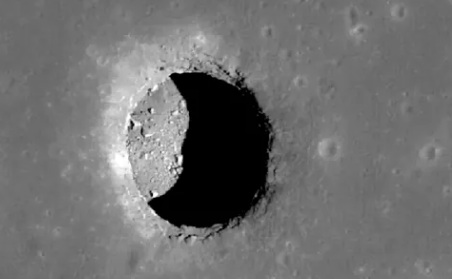Science Fiction
Dictionary
A B C D E F G H I J K L M N O P Q R S T U V W X Y Z
Goldilocks Zones Found On The Moon

A NASA-funded study has revealed that there are about 200 shaded places on the Moon where the temperature is comfortable for humans.

(The moon's Tranquillitatis pit)
The moon has wild temperature fluctuations, with parts of the moon heating up to 260 degrees Fahrenheit (127 degrees Celsius) during the day and dropping to minus 280 F (minus 173 C) at night. But the newly analyzed 200 shaded lunar pits are always always 63 F (17 C), meaning they're perfect for humans to shelter from the extreme temperatures. They could also shield astronauts from the dangers of the solar wind, micrometeorites and cosmic rays. Some of those pits may lead to similarly warm caves.These partially-shaded pits and dark caves could be ideal for a lunar base, scientists say.
In the new study, researchers analyzed the temperatures within a cylindrical pit about 328 feet (100 meters) deep in the Mare Tranquillitatis — the Sea of Tranquility — near the moon's equator. The team's findings revealed that while the pit's floor is illuminated at lunar noon, it's probably the hottest place on the entire surface of our natural satellite, at around 300 F (149 C); meanwhile, temperatures within the permanently shadowed reaches of the pit fluctuate only slightly from Earthlike hoodie temperatures.
(Via livescience.)
Science fiction fans may recall that in Star Wars: The Empire Strikes Back, Han and Leia find themselves in what seems to be a cave on an asteroid. They venture out using only masks and breathing apparatus, not needing space suits.
Of course, just because the temperature of a pit on the Moon is room temperature, it does not mean that space suits are not needed; the pit is still in vacuum. However, there have been observations that indicate that water ice might be found in shadowed lunar craters. So, it's not impossible that there might be some sort of partial pressure provided in these areas.
Scroll down for more stories in the same category. (Story submitted 8/19/2022)
Follow this kind of news @Technovelgy.| Email | RSS | Blog It | Stumble | del.icio.us | Digg | Reddit |
Would
you like to contribute a story tip?
It's easy:
Get the URL of the story, and the related sf author, and add
it here.
Comment/Join discussion ( 0 )
Related News Stories - (" Space Tech ")
Will Space Stations Have Large Interior Spaces Again?
'They filed clumsily into the battleroom, like children in a swimming pool for the first time, clinging to the handholds along the side.' - Orson Scott Card, 1985.
Reflect Orbital Offers 'Sunlight on Demand' And Light Pollution
'I don't have to tell you about the seven two-mile-diameter orbital mirrors...'
Chrysalis Generation Ship to Alpha Centauri
'This was their world, their planet —
this swift-traveling, yet seemingly moveless vessel.' - Nat Schachner, 1934
The First Space Warship For Space Force
'Each of the electrical ships carried about twenty men...' - Garrett P. Serviss, 1898.
Technovelgy (that's tech-novel-gee!) is devoted to the creative science inventions and ideas of sf authors. Look for the Invention Category that interests you, the Glossary, the Invention Timeline, or see what's New.
Science Fiction
Timeline
1600-1899
1900-1939
1940's 1950's
1960's 1970's
1980's 1990's
2000's 2010's
Current News
Sunday Robotics 'Memo
'He then started hand movements of definite pattern...'
Woman Marries Computer, Vonnegut's Dream Comes True
'Men are made of protoplasm... Lasts forever.'
Natural Gait With Prosthetic Connected To Nervous System
'The leg was to function, in a way, as a servo-mechanism operated by Larry’s brain...'
Spidery 'Walk Me' Toyota Autonomous Wheel Chair Like Star Wars
Walk along with the emperor.
Dancing Robots Taught Dance Moves
'A clockwork figure would be the thing for you...'
Proof Of Robothood - Not A Person
'Who are you people? - Show 'em.'
Indonesian Clans Battle
'The observation vehicle was of that peculiar variety used in conveying a large number of people across rough terrain.'
The 'Last Mile' In China Crowded With Delivery Robots
Yes, it's a delivery robot. On wheels.
Tornyol Microdrone Kills Mosquitoes
'The real border was defended by... a swarm of quasi-independent aerostats.'
PLATO Spacecraft, Hunter Of Habitable Planets, Now Ready
'I ... set my automatic astronomical instruments to searching for a habitable planet.'
Factory Humanoid Robots Built By Humanoid Robots
'...haven't you a section of the factory where only robot labor is employed?'
iPhone Air Fulfils Jobs' Promise From 2007 - A Giant Screen!
'... oblongs were all over the floor and surfaces.'
ChatGPT Now Participates in Group Chats
'...the city was their laboratory in human psychology.'
iPhone Pocket All Sold Out!
'A long, strong, slender net...'
Did The Yautja Have These First?
What a marvel of ingenuity the little device was!
Jetson ONE Air Races Begin, Can Air Polo Be Far Behind?
'If you're one of those rarities who haven't attended a rocket-polo "carnage", let me tell you it's a colorful affair.'
